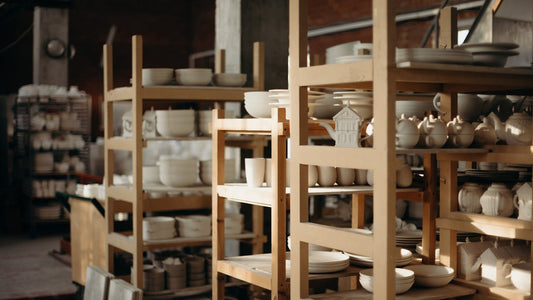Wissen

Von Ton zu Textil: Warum Keramiker so oft in an...
Wer einmal mit Ton gearbeitet hat, kennt diesen Moment, in dem man völlig im Rhythmus versinkt. Der Körper wird ruhig, der Kopf wird ausgeschaltet, die Hände übernehmen und es entsteht...
Von Ton zu Textil: Warum Keramiker so oft in an...
Wer einmal mit Ton gearbeitet hat, kennt diesen Moment, in dem man völlig im Rhythmus versinkt. Der Körper wird ruhig, der Kopf wird ausgeschaltet, die Hände übernehmen und es entsteht...

Kittec Brennofen-Linien erklärt
Inhaltsverzeichnis Warum die Line wichtiger ist als das Modell Wie du arbeitest – typische Anwendungssituationen Überblick: Kittec-Lines im Vergleich CB Classic-Line CBN Classic-Line SQ Squadro CT Classic-Line (CT-3 & CT-5)...
Kittec Brennofen-Linien erklärt
Inhaltsverzeichnis Warum die Line wichtiger ist als das Modell Wie du arbeitest – typische Anwendungssituationen Überblick: Kittec-Lines im Vergleich CB Classic-Line CBN Classic-Line SQ Squadro CT Classic-Line (CT-3 & CT-5)...

Ideen zum Töpfern: Diese Keramikstücke kannst d...
Töpfern ist längst kein angestaubtes Hobby mehr. Überall öffnen neue Töpferstudios, Kurse sind Monate im Voraus ausgebucht und handgemachte Keramik füllt die Seiten von Interior Magazinen. Immer mehr Menschen entdecken...
Ideen zum Töpfern: Diese Keramikstücke kannst d...
Töpfern ist längst kein angestaubtes Hobby mehr. Überall öffnen neue Töpferstudios, Kurse sind Monate im Voraus ausgebucht und handgemachte Keramik füllt die Seiten von Interior Magazinen. Immer mehr Menschen entdecken...
Frequently Asked Questions
How much does a loom cost?
The cost of a weaving loom can vary depending on the type, size, quality, and function. Weaving looms are typically significantly cheaper than looms and are therefore often used by beginners or even children. Simple weaving looms are usually available for around €30, such as this handmade loom . Advanced looms can cost up to €400. These looms also have special features or weaving widths of up to 70 cm, such as the Glimåkra Susanna loom .
How does a weight loom work?
Weight looms are mounted on the floor and the wall or ceiling. The warp threads are attached to the top of the moving warp beam and tensioned at the bottom with weaving weights, which give the loom its name. Weaving occurs from top to bottom. A weaving comb interweaves the warp threads at the ends, if necessary, for clean selvedges.
Weaving weights have been documented in Europe since around 6000 BC. Uniform weights are important to ensure even tension on the warp threads. For uneven weights, stones should be balanced and the appropriate number of warp threads should be added.
Weight looms originally had limited weaving sizes due to the reach of human arms. The largest surviving piece, a Danish coat, measures 2.35 m x 1.30 m.
What is a countermarch loom?
A countermarch loom is a loom that uses a special device to suspend the shafts to facilitate weaving. Unlike the more primitive rocker method, in which two shafts are always lowered or raised simultaneously, the countermarch loom allows for better shedding because both the shafts being raised and the shafts being lowered are connected. This requires not only treadle mechanisms but also crosspieces to control each shaft individually. These crosspieces are located at different levels and facilitate the connection of the shafts to the treadles.
The pulley loom uses metal pulleys, unlike wooden rockers. There are various ways to implement the lacing and lifting/unlifting mechanisms, and it's advisable to do your research before deciding to purchase such a loom.
Is weaving difficult?
Weaving can be challenging at first, especially if you're new to textiles. The difficulty depends on several factors, including the desired weave pattern, the type of loom, and your own skills. With practice and guidance, weaving can be learned relatively quickly, and many people find it a deeply satisfying craft. Since there are varying levels of difficulty in weaving, depending on the chosen patterns, both beginners and advanced weavers can find their own path. Beginner courses are available in most major cities. If you don't have a weaving course nearby, you can now find various online tutorials on YouTube.
Welche Fehler passieren Anfängern beim Töpfern am häufigsten?
Viele Anfänger haben zu wenig Geduld und wollen zu schnell zu viel. Häufige Fehler sind zu nasser oder zu trockener Ton, ungleichmäßiges Drehen auf der Scheibe und zu schnelles Trocknen, wodurch Risse entstehen. Auch das falsche Entlüften beim Kneten oder ein zu dicker Boden beim Drehen führen oft zu Problemen. Wichtig ist, langsam, sorgfältig und mit Gefühl zu arbeiten. Der Rest kommt mit Übung.

